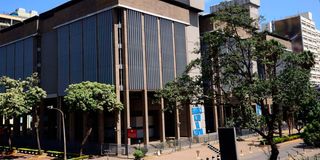Interbank lending rate at 55-month high on tight cash

The Central Bank of Kenya building in Nairobi.
The cost of borrowing between commercial banks has hit the highest mark in 55 months amid tightening cash supply and pointing to fresh surges in the pricing of credit by the lenders.
Data by the Central Bank of Kenya (CBK) shows that the interbank rate—the interest charged on short-term loans between banks—stood at 10.40 percent on July 21, 2023, which is the highest level since 11.34 percent on December 14, 2018.
Banks may borrow money from other banks to ensure that they have enough liquidity for their immediate needs, or lend money when they have excess cash on hand. The interbank lending system is short-term, typically overnight, and rarely more than a week.
The daily average borrowings by banks from their peers stood at Sh24.3 billion for the period July 14-20, up from Sh14.3 billion for the July 7-13 window. On Friday alone banks tapped Sh15.55 billion from the interbank market.
This comes as CBK reports showed liquidity in the money market decreased during the week ended July 20, as government receipts more than offset government payments. Commercial banks’ reserves stood at a shortfall of Sh 18.2 billion concerning the 4.25 percent cash reserves requirement while the average number of interbank deals increased to 48 in the week ended July 20 from 25 in the previous week.
The tight liquidity position is further manifested through a scramble for deposits by banks. Kenyan banks have raised the interest rates charged on fixed deposits to a five-year high to attract new funds from wealthy clients as they sought to curtail outflows amid tightened liquidity conditions.
Liquidity
Data by the CBK shows that banks were offering an average 7.7 percent deposit rate as of May 2023—the highest since June 2018-- amid the rising cost of funds for lending and tightened liquidity in the market.
Conventionally, financial institutions offer better rates for accounts holding larger balances as an incentive to attract high-value clients with considerable assets. The catch here is that with the higher interest rates, the greater the sum that is deposited, the larger the return over time.
Customarily, cash-rich firms and individuals dominate the fixed deposit market where most accounts have millions of shillings locked up for months to one year. Banks don’t pay interest on most savings accounts, with those that do earning substantially lower rates than those on fixed deposit accounts.
The five-year-high deposit rate signals that banks are keen on raising funds to increase their lending amid improved economic activity despite tightened liquidity in the market due to a rise in base lending rates and subsequent short-term government securities rates as the lenders are forced to attract larger depositors to keep their money with them instead of lending to the State.
Private sector
High returns on short-term government securities signal a penchant for lending to the State rather than the private sector due to the low-risk nature of the investment.
Banks have been increasing their appetite for government papers given the sustained rise in yields on T-bonds and T-bills. For instance, the average interest on the benchmark 91-day Treasury bills during last week’s sale hit 12.33 percent, the highest since November 2015 when it averaged 12.34 percent.
Commercial banks have been increasing their loan charges in line with CBK's decision to raise its indicative rate to 10.5 percent which was last seen in July 2016. The Monetary Policy Committee (MPC) of the CBK on June 27 made a surprise raise in the Central Bank Rate (CBR) by one percentage from 9.5 percent, setting the benchmark lending rate at the highest level since July of 2016 or an 82-month high.





